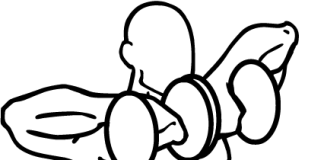Last Updated on September 25, 2014
Jefferson Squats with Barbell, a unique and often overlooked exercise, is one of the best movements for building and shaping the inner thighs. Named after the famous strongman Charles Jefferson, this squat variation not only targets the inner thighs (adductors) but also works the glutes, quads, hamstrings, and core. In this comprehensive guide, we’ll delve into everything you need to know about the Jefferson Squat, including how to perform it correctly, the muscles it works, benefits, variations, and common mistakes to avoid.
What are Jefferson Squats?
The Jefferson Squat is a compound exercise that requires balance, coordination, and strength. Unlike traditional squats, which involve positioning the barbell on your shoulders, Jefferson Squats place the barbell between your legs. This unique setup shifts the center of gravity, activating different muscle groups and engaging the inner thighs more effectively than standard squats or lunges.
The Jefferson Squat’s unconventional form might seem intimidating at first, but with practice and proper technique, it becomes an invaluable exercise for lower body development.
Muscles Worked in Jefferson Squats
This exercise is highly effective for building the lower body due to its multi-muscle engagement. The primary muscles worked during Jefferson Squats include:
- Adductors (Inner Thighs): The positioning of the barbell and the wide stance emphasize the adductors, helping shape and strengthen the inner thigh muscles.
- Glutes: The deep squat position activates the glutes, making it a great exercise for building a fuller, stronger backside.
- Quadriceps: As you stand up from the squat position, your quads are heavily engaged.
- Hamstrings: The movement also recruits the hamstrings for stability and strength.
- Core and Obliques: Balancing the barbell between your legs requires core stability and activation of the oblique muscles.
- Grip and Forearms: Holding the barbell with an overhand grip activates the forearms and strengthens your grip.
How to Perform Jefferson Squats with Barbell: Step-by-Step Guide
The Jefferson Squat requires a focus on balance and stability. Here’s how to perform the movement correctly:
- Set Up:
- Place a barbell on the floor so it is positioned between your legs and perpendicular to your feet.
- Stand with your feet slightly wider than shoulder-width apart, straddling the barbell. One foot should be slightly in front of the other to establish a stable stance.
- Grasp the Barbell:
- Squat down so your thighs are parallel to the floor.
- Reach down and grab the barbell with both hands, one hand in front of you and the other behind. Use an overhand grip with both hands. This staggered grip allows for greater control and balance.
- Your back should be straight, and your chest should be lifted as you prepare to lift the barbell.
- Lift the Weight:
- Push through your heels and engage your core as you lift the barbell up between your legs.
- Stand up straight, keeping your torso upright and your back neutral. Your arms should remain extended, holding the barbell securely.
- At the top of the movement, pause for a moment to ensure balance and control.
- Return to the Starting Position:
- Slowly lower the barbell back down by bending your knees and hips, maintaining a controlled descent.
- Stop just before the barbell touches the ground, keeping tension in your legs and core.
- Repeat for the desired number of repetitions, focusing on slow and controlled movements.
Tips for Proper Form
To get the most out of Jefferson Squats and reduce the risk of injury, consider these key tips:
- Engage Your Core: A strong core helps stabilize your torso, keeping your spine in a neutral position and preventing injury.
- Focus on Balance: Since the barbell is positioned between your legs, balance is crucial. Adjust your feet and stance as needed to maintain stability throughout the movement.
- Use Light Weight Initially: Start with a light barbell or even a broomstick to get used to the movement before progressing to heavier weights.
- Keep Your Chest Up: Avoid leaning forward too much. Keeping your chest up and back straight ensures proper posture and engages the right muscles.
- Breathe Properly: Inhale as you squat down and exhale as you stand up, maintaining a steady breathing pattern to support the movement.
Benefits of Jefferson Squats
- Enhanced Inner Thigh Development: Jefferson Squats are particularly effective for targeting the adductors, which can be difficult to isolate with other exercises.
- Functional Strength and Stability: The offset stance and grip improve balance and core stability, translating to better performance in daily activities and other compound lifts.
- Glute Activation: The deep squat position ensures full glute engagement, helping to build and shape the glute muscles effectively.
- Improved Hip Mobility: The wide stance and range of motion improve hip flexibility and mobility, which is crucial for injury prevention and overall movement efficiency.
- Versatility and Variety: Adding Jefferson Squats to your workout routine offers a fresh alternative to traditional squats and lunges, preventing workout monotony and providing a new challenge for muscle development.
Variations of Jefferson Squats
If you want to mix things up or progress further, here are some variations of Jefferson Squats that can help you target different muscle groups and increase the intensity:
1. Dumbbell Jefferson Squats
Instead of using a barbell, perform the movement with a dumbbell in each hand. This variation reduces the load on your spine and allows for greater freedom of movement.
- How to Perform: Hold a dumbbell in each hand and position them between your legs. Perform the same squatting and lifting motion as with the barbell, ensuring your arms remain straight and your back stays upright.
2. Single-Arm Jefferson Squats
This variation challenges your core stability and balance further by holding the barbell with only one hand.
- How to Perform: Grasp the barbell with one hand in the center and perform the squat as usual. Focus on engaging your core to maintain balance and prevent the barbell from tipping to one side.
3. Jefferson Deadlifts
For more emphasis on the hamstrings and glutes, perform Jefferson Squats with a deadlift variation. This involves bending over more and lifting the weight from the floor each time.
- How to Perform: Start with the barbell between your legs as usual, but instead of keeping your torso upright, hinge at the hips like a deadlift. Lower the barbell to the floor each time and lift it with a focus on hip hinge mechanics.
Common Mistakes to Avoid
Jefferson Squats, while effective, can be tricky to master due to their unconventional form. Here are some common mistakes and how to avoid them:
- Using Too Much Weight Too Soon: Jefferson Squats require balance and coordination, which can be difficult with heavy weights, especially for beginners. Start light and focus on mastering the technique before progressing to heavier loads.
- Rounding the Back: A rounded back can lead to injury, particularly in the lower spine. Keep your core engaged and back straight throughout the movement.
- Incorrect Foot Placement: The staggered stance is key to the Jefferson Squat. Ensure one foot is slightly forward and the other back, providing stability and balance. Experiment with foot positioning until you find what feels comfortable.
- Neglecting Core Engagement: Failing to engage your core can result in a loss of balance and poor posture. Keep your abs tight to maintain a strong, stable position.
- Leaning Forward: This is a common error that shifts the weight away from the legs and puts unnecessary pressure on the lower back. Focus on keeping your chest up and your weight distributed evenly between your feet.
Programming Jefferson Squats into Your Workout
Incorporating Jefferson Squats into your training program can provide significant lower body gains and enhance functional strength. Here’s how to include them effectively:
- Warm-Up Activation: Use Jefferson Squats with light weight as part of your warm-up routine to activate your adductors, glutes, and quads.
- Leg Day Routine: Include 3-4 sets of Jefferson Squats in your leg day workout, using a moderate weight for 8-12 reps per set.
- Functional Strength Circuits: Add Jefferson Squats to a functional training circuit, pairing them with lunges, deadlifts, and core exercises for a balanced and dynamic workout.
FAQs About Jefferson Squats
Q1: Are Jefferson Squats suitable for beginners?
Yes, Jefferson Squats can be performed by beginners, but it’s crucial to start with a light barbell or an empty bar to master the technique. Practice without any weight until you feel comfortable balancing and squatting in the Jefferson stance.
Q2: Can I use Jefferson Squats for muscle building?
Absolutely. Jefferson Squats are excellent for building muscle, especially in the inner thighs and glutes. Gradually increase the weight over time to see muscle growth and strength gains.
Q3: Are Jefferson Squats safe for the knees?
When performed with proper form and technique, Jefferson Squats are safe for the knees. Ensure you squat down with your thighs parallel to the floor, keeping your weight balanced through your heels to reduce knee strain.
Final Tips for Success with Jefferson Squats
To make the most of this exercise, remember:
- Practice Without Weight First: If you’re new to Jefferson Squats, practice the movement with just your body weight or an empty barbell. This helps you get used to the stance and balance required before adding any resistance.
- Warm Up Properly: As with any compound movement, warming up your hips, legs, and core is crucial. Dynamic stretches like lunges, hip circles, and light squats can prepare your muscles for the load.
- Gradually Increase the Weight: Once you’re comfortable with the form, progressively increase the weight in small increments. This approach allows your body to adapt and build strength safely.
- Listen to Your Body: If you feel any discomfort or pain, particularly in your knees or lower back, reduce the weight or check your form. It’s essential to execute the exercise correctly to prevent injury.
Jefferson Squats with a barbell may not be as common as traditional squats or lunges, but their effectiveness in targeting the inner thighs and developing overall lower body strength is undeniable. By mastering the technique and gradually increasing the challenge, this exercise can become a staple in your lower body workouts. It offers not only muscle-building benefits but also enhances balance, coordination, and functional strength.
Embrace the versatility of Jefferson Squats and enjoy the progress they bring to your strength training routine. Whether you are an athlete looking to improve your performance, a bodybuilder aiming to sculpt your legs, or a fitness enthusiast seeking new challenges, Jefferson Squats can provide the variety and results you’re looking for.






